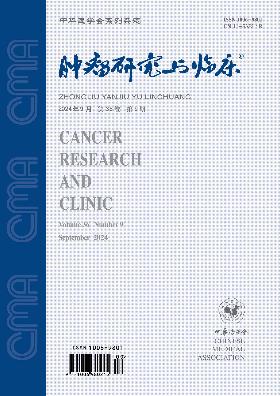Effect of anesthesia depth on stress response during single-lung ventilation in thoracic surgery
Q4 Medicine
引用次数: 1
Abstract
Objective To study the effects of different anesthesia depths on stress response during single-lung ventilation in patients with thoracoscopic lobectomy. Methods Sixty patients selected for elective thoracoscopic lobectomy in the Second Hospital of Shanxi Medical University from September 2018 to May 2019 were randomly divided into three groups according to the digital random table method, with 20 patients in each group. Group A maintained deep anesthesia with the bispectral index (BIS) 36-45, group B maintained moderate anesthesia with BIS 46-55, and group C did not undergo BIS monitoring. The changes of heart rate, mean arterial pressure (MAP), stress indexes cortisol and blood glucose before anesthesia induction (T0), immediately after one-lung ventilation (T1), 60 min after one-lung ventilation (T2) and immediately after skin suture (T3) in the three groups were compared. Results The concentration of blood glucose in group A at T1, T2 and T3 was (5.28±0.49) mmol/L, (5.34±0.49) mmol/L and (5.40±0.47) mmol/L, and the cortisol was (142.75±31.45) ng/ml, (181.36±19.62) ng/ml and (153.81±33.92) ng/ml; the blood glucose in group B was (5.63±0.35) mmol/L, (6.06±0.19) mmol/L and (5.79±0.44) mmol/L, and the cortisol was (168.45±31.16) ng/ml, (171.09±25.28) ng/ml and (159.39±18.77) ng/ml; the blood glucose in group C was (6.35±0.56) mmol/L, (7.04±0.26) mmol/L and (6.17±0.54) mmol/L, and the cortisol was (191.13±46.00) ng/ml, (283.25±30.07) ng/ml and (183.01±19.71) ng/ml, respectively. The blood glucose and cortisol levels in group C at T1, T2 and T3 were higher than those in group A and group B (all P < 0.05). The MAP in group A at T1, T2 and T3 were (69±5) mmHg (1 mmHg= 0.133 kPa), (67±6) mmHg and (75±7) mmHg, respectively, and group B was (80±8) mmHg, (79±4) mmHg and (84±9) mmHg, the differences between the two groups were statistically significant (all P < 0.05). There was significant difference in cortisol between group A and group B at T1 (P < 0.05). The heart rate and MAP at T1, T2 and T3 in group A and group C were significantly different from those at T0 (all P < 0.05). The heart rate and MAP at T1 and T2 in groups B were significantly different from those at T0 (all P < 0.05). Conclusion BIS anesthesia depth monitoring should be performed during single-lung ventilation in thoracic surgery, and BIS should be maintained at 46-55, which can not only inhibit the stress response but also have a slight effect on hemodynamics. Key words: Surgical procedures, operative; Monitoriry, intraoperative; Stress; Depth of anesthesia; Bispectral index monitoring麻醉深度对胸外科单肺通气应激反应的影响
目的探讨不同麻醉深度对胸腔镜肺叶切除术患者单肺通气应激反应的影响。方法选择2018年9月至2019年5月山西医科大学第二医院择期胸腔镜肺叶切除术患者60例,按数字随机表法随机分为3组,每组20例。A组以BIS 36-45维持深度麻醉,B组以BIS 46-55维持中度麻醉,C组不进行BIS监测。比较三组患者麻醉诱导前(T0)、单肺通气后立即(T1)、单肺通气后60 min (T2)和皮肤缝合后立即(T3)心率、平均动脉压(MAP)、应激指标皮质醇和血糖的变化。结果A组患者T1、T2、T3时血糖浓度分别为(5.28±0.49)mmol/L、(5.34±0.49)mmol/L、(5.40±0.47)mmol/L,皮质醇分别为(142.75±31.45)ng/ml、(181.36±19.62)ng/ml、(153.81±33.92)ng/ml;B组血糖分别为(5.63±0.35)mmol/L、(6.06±0.19)mmol/L和(5.79±0.44)mmol/L,皮质醇分别为(168.45±31.16)ng/ml、(171.09±25.28)ng/ml和(159.39±18.77)ng/ml;C组血糖分别为(6.35±0.56)mmol/L、(7.04±0.26)mmol/L和(6.17±0.54)mmol/L,皮质醇分别为(191.13±46.00)ng/ml、(283.25±30.07)ng/ml和(183.01±19.71)ng/ml。C组患者T1、T2、T3时血糖、皮质醇水平均高于A、B组(均P < 0.05)。A组T1、T2、T3时MAP分别为(69±5)mmHg (1 mmHg= 0.133 kPa)、(67±6)mmHg、(75±7)mmHg, B组为(80±8)mmHg、(79±4)mmHg、(84±9)mmHg,两组间差异均有统计学意义(P < 0.05)。在T1时,A组与B组的皮质醇水平差异有统计学意义(P < 0.05)。A组和C组T1、T2、T3时心率和MAP与T0时比较差异均有统计学意义(P < 0.05)。B组T1、T2时心率、MAP与T0时比较差异均有统计学意义(P < 0.05)。结论胸外科手术单肺通气时应进行BIS麻醉深度监测,BIS维持在46 ~ 55之间,既能抑制应激反应,又对血流动力学有轻微影响。关键词:外科手术;Monitoriry,术中;压力;麻醉深度;双谱指数监测
本文章由计算机程序翻译,如有差异,请以英文原文为准。
求助全文
约1分钟内获得全文
求助全文
来源期刊

肿瘤研究与临床
Medicine-Oncology
CiteScore
0.10
自引率
0.00%
发文量
7737
期刊介绍:
"Cancer Research and Clinic" is a series of magazines of the Chinese Medical Association under the supervision of the National Health Commission and sponsored by the Chinese Medical Association.
It mainly reflects scientific research results and academic trends in the field of malignant tumors. The main columns include monographs, guidelines and consensus, standards and norms, treatises, short treatises, survey reports, reviews, clinical pathology (case) discussions, case reports, etc. The readers are middle- and senior-level medical staff engaged in basic research and clinical work on malignant tumors.
 求助内容:
求助内容: 应助结果提醒方式:
应助结果提醒方式:


